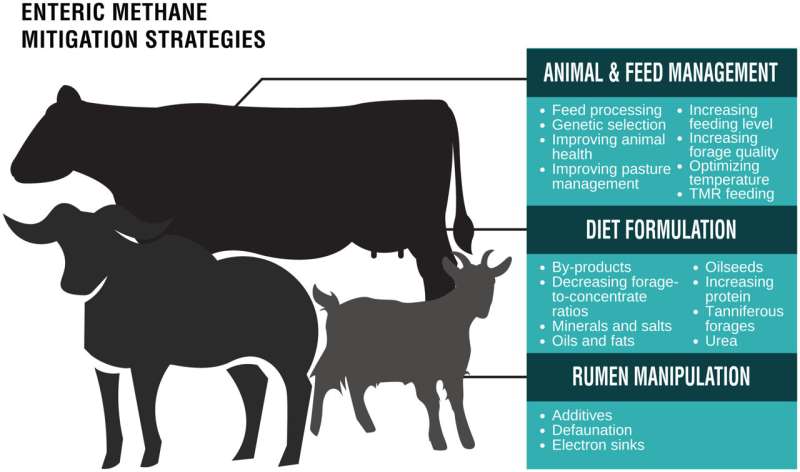Credit: Proceedings of the National Academy of Sciences (2022). DOI: 10.1073/pnas.2111294119
Amid the often-distressing news about climate change, some good news: Existing strategies could mitigate livestock methane emissions by enough to help the sector limit its share of global warming to the 1.5°C target by 2030.
In a meta-analysis published in The Proceedings of the National Academy of Sciences (PNAS), Claudia Arndt, Leader of the Mazingira Center at the International Livestock Research Institute in Kenya, and a score of experts from top-level institutes around the world reviewed hundreds of peer-reviewed studies for strategies designed to decrease product-based and absolute enteric methane emissions by ruminants. The research was initiated by Alexander N. Hristov at Penn State University. They found that livestock production could help meet the 1.5°C target by 2030—with the provision that the identified most effective product-based and the most effective absolute mitigation strategies be fully adopted, a goal that would require concerted action to identify and remove adoption barriers.
However, scientists caution that to stay on track by 2050, additional strategies will be needed due to a projected increased demand in livestock products. Thus, current strategies can meet short-term targets, but further research is needed to develop strategies sufficient to meet longer-run targets.
Microbes in the digestive tract of ruminants decompose and ferment feed, a process called enteric fermentation, producing methane as one of the by-products. The world's >3 billion ruminants belch out the methane, contributing 30% of global anthropogenic methane emissions. Ruminants provide about half the animal protein produced by livestock. In low- and middle-income countries (where 84% of the world's population live), consumption of animal-source foods is often below recommended dietary levels. In these countries, ruminant livestock play a critical role in food security and provide a host of other benefits such as traction and manure for fuel and fertilizer. In contrast, in high-income countries, the consumption of animal protein is often above recommended levels.
Because of ruminants' multiple uses and their contribution to the Sustainable Development Goals, the authors focused on strategies that reduce enteric methane production without reducing animal productivity.
They identified three strategies that could reduce methane emission per unit of meat or milk on average by 12% while increasing animal productivity. The strategies were increasing feed intake level, having ruminants graze on less mature grass, and feeding increasing levels of concentrate. In addition, they identified five strategies that could reduce not only product-based on average by 17% but also absolute methane emissions on average by 21%, while maintaining animal productivity. The strategies include supplementing animals with methane inhibitors, oils and fats, oilseeds, or nitrate (electron acceptors) as well as feeding tanniferous forages.
The authors also looked at how the implementation of the identified strategies could help to reduce global, European and African methane emissions by livestock. They found that the full adoption of the most effective strategies could help meet the global 2030 but not the 2050 target. In Europe, they found multiple scenarios that did not require full adoption of the most effective strategies to meet the 2030 targets and that full adoption of the most effective strategies could meet the 2050 target. In Africa, by contrast, even though substantial reductions could be achieved, the identified strategies would not be sufficient to fully meet either the 2030 or 2050 target. This is because of Africa's growing human population and per capita demand for animal products, which are expected to lead to a substantial increase in livestock production and greenhouse gas emissions. Still, its projected increase will be below European per capita demand.
"The paper shows that there are effective strategies to reduce enteric methane emissions which can help meet the global 1.5°C target by 2030 but not 2050. As complete adoption of the most effective strategies by 2030 is unlikely and the target cannot be reached by 2050 with the identified strategies, other proposed means of decreasing methane emissions are necessary. Such strategies could be to remove emissions from the supply and demand side in the livestock sector," said ILRI scientist Claudia Arndt.
More information: Claudia Arndt et al, Full adoption of the most effective strategies to mitigate methane emissions by ruminants can help meet the 1.5 °C target by 2030 but not 2050, Proceedings of the National Academy of Sciences (2022). DOI: 10.1073/pnas.2111294119
Journal information: Proceedings of the National Academy of Sciences
Provided by International Livestock Research Institute























